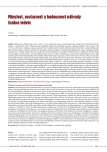Bone disease in chronic renal failure and its modern therapy
Authors:
S. Dusilová Sulková
Authors‘ workplace:
Klinika nefrologie, Transplantační centrum IKEM Praha, přednosta prof. MUDr. Ondřej Viklický, CSc.
Published in:
Vnitř Lék 2011; 57(7&8): 620-625
Category:
136th internal medicine day, XXIV. Vanýskův den, Brno 2011
Overview
Renal bone disease is one of the most serious complications of chronic renal failure. Secondary hyperparathyreosis is decisive for its pathogenesis. Current prevention and treatment emphasises pathogenetic and clinical interrelationships between bone tissue involvement and cardiovascular complications (CKD-MBD, bone and venous involvement associated with chronic renal disease). The treatment should first correct hyperphosphatemia and, subsequently, hyperreactivity of parathyroid glands through vitamin D receptor (VDR) and calcium receptor (CaR) modulation. Three groups of drugs play a fundamental role here (GIT phosphate binders, calcimimetics and vitamin D receptor activators). Certain other therapeutic approaches are used in some specific situations such as, among others, refractory hyperparathyreosis or calciphylaxis.
Key words:
chronic renal failure – bone disease – secondary hyperparathyreosis
Sources
1. Dusilová Sulková S a kol. Renální osteopatie. Praha: Maxdorf Jessenius 2007.
2. Dusilová Sulková S. Kostní a minerálová porucha při chronickém onemocnění ledvin – přehled problematiky. Osteol Bull 2008; 13: 144–151.
3. Martin KJ, González EA. Metabolic bone disease in chronic kidney disease. J Am Soc Nephrol 2007; 18: 875–835.
4. Martin KJ, Olgard K, Coburn JW et al. Bone Turnover Work Group. Diagnosis, assessment and treatment of bone turnover abnormalities in renal osteodystrophy. Am J Kidney Dis 2004; 43: 558–565.
5. London GM, Guerin AP, Marchais SJ et al. Arterial media calcification in end-stage renal disease: impact on all-cause and cardiovascular mortality. Nephrol Dial Transplant 2003; 18: 1731–1740.
6. Moe SM, Drüeke TB, Cunningham J et al. Kidney Disease: Improving Global Outcomes (KDIGO). Definition, evaluation and classification of renal osteodysstrophy. A position statement from kidney disease: Improving Global Outcomes (KDIGO). Kidney Int 2006; 69: 1945–1953.
7. Cunningham J, Locatelli F, Rodriguez M. Secondary hyperparathyroidism: pathogenesis, disease progression and therapeutic options. Clin J Am Soc Nephrol 2011; 6: 913–921.
8. Martin KJ, González EA. Prevention and control of phosphate retention/hyperphosphatemia in CKD-MBD: What is normal, when to start and how to treat. Clin J Am Soc Nephrol 2011; 6: 440–446.
9. Rodriguez M, Canalejo A, Garfia B et al. Pathogenesis of refractory secondary hyperparathyroidism. Kidney Int 2002; 61: S155–S160.
10. Dusilová Sulková S, Opatrná S, Ryšavá R et al. KDIGO doporučení pro diagnostiku a léčbu CKD-MBD: komentovaný návod pro klinickou praxi. Aktuality v nefrologii 2010; 16: 113–126.
11. Kidney Disease: Improving Global Outcome (KDIGO) CKD-MBD working group. KDIGO clinical practice guideline for the diagnosis, evaluation, preventive and treatment of chronic kidney disease – mineral bone disorder (CKD-MBD). Kidney Int 2009; 76 (Suppl 113): S1–S130.
12. National Kidney Foundation: K/DOQI clinical practice guidelines for bone metabolism and disease in chronic kidney disease. Am J Kidney Dis 2003; 42 (4 Suppl 3): S1–S201.
13. Komaba H, Nakanishi S, Fujimori A et al. Cinacalcet effectively reduces parathyroid hormone secretion and gland volume regardless of pretreatment gland size in patients with secondary hyperparathyroidism. Clin J Am Soc Nephrol 2010; 5: 2305–2314.
14. Block GA, Zaun D, Smits G et al. Cinacalcet hydrochloride treatment significantly improves all-cause and cardiovascular survival in a large cohort of hemodialysis patients. Kidney Int 2010; 78: 578–589.
15. Souberbielle JC, Cavaleire E, Jean G. Interpretation of serum parathyroid hormone concentrations in dialysis patients: what do the KDIGO guidelines change for clinical laboratory? Clin Chem Lab Med 2010; 48: 769–774.
16. Dusso AS, Tokumoto M. Defective renal maintenance of the vitamin D endocrine system impairs vitamin D renoprotection: a downeard spiral in kidney disease. Kidney Int 2011; 79: 715–729.
17. Szeto CC, Li PKT. The use of vitamin D analogues in chronic kidney diseases: possible mechanisms betone bone and mineral metabolism. NDT Plus 2009; doi.10.1093/ndtplus/sfp034.
18. Emmet M. A comparison of clinically useful phosphorus binders for patients with chronic kidney failure. Kidney Int 2004; 66 (Suppl 90): S25–S32.
19. McIntyre CW. New developments in the management of hyperphosphatemia in chronic kidney disease. Semin Dial 2007; 20: 337–341.
20. Gordon PL, Frassetto LA. Management of osteoporosis in CKD stages 3 to 5. Am J Kidney Dis 2010; 55: 941–956.
21. Toussaint ND, Elder GJ, Kerr PG. Bisphosphonates in chronic kidney disease; balancing potential benefits and adverse effects on bone and soft tissue. Clin J Am Soc Nephrol 2009; 4: 221–233.
22. Tominaga Y, Matsuoka S, Uno N et al. Parathyreoidectomy for secondary hyperparathyroidism in the era of calcimimetics. Ther Apher Dial 2008; 12 (Suppl 1): S21–S26.
23. Rodriguez M, Nemeth E, Martin D. The calcium-sension receptor: a key factor in the pathogenesis of secondary hyperparathyroidism. Am J Physiol Renal Physiol 2005; 288: 253–264.
24. Moe SM, Chen NX. Pathophysiology of vascular calcification in chronic kidney disease. Clin Res 2004; 95: 560–567.
25. Dusilová Sulková S, Válek M. Skin wounds associated with calciphylaxis in end-stage renal disease patients on dialysis. Nutrition 2010; 26: 910–914.
26. Floege J, Kim J, Ireland E et al. ARO Investigators. Serum iPTH, calcium, phosphate, and the risk of mortality in a European hemodialysis population. Nephrol Dial Transplant 2010. [Epub ahead of print].
27. Kalantar-Zadeh K, Shah A, Duoung U et al. Kidney bone disease and mortality in CKD: revisiting the role of vitamin D, calcimimetics, alkaline phosphatase, and minerals. Kidney Int 2010; 78 (Suppl 117): S10–S21.
Labels
Diabetology Endocrinology Internal medicineArticle was published in
Internal Medicine

2011 Issue 7&8
Most read in this issue
- Haemodialysis – the current practice
- Anemia and chronic kidney failure
- Immunosuppressive therapy and its problems
- Aetiology and a clinical picture of chronic renal failure
